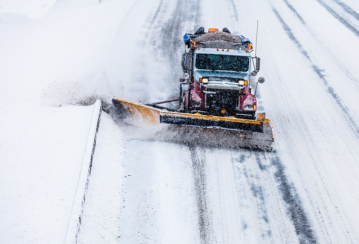News and Updates
Winter driving safety: Snow plows
As winter weather is beginning to set in and roads will require more clearing, we caution drivers to keep a safe distance from snow plows. Trying to pass a snow plow could result in a severe – even fatal – collision. That's why the Ontario government has amended the Highway Traffic Act to create a new offence, making it illegal for drivers to pass snow plows in formation with other plows. Read on to learn more about this amendment and other winter driving safety tips.
Snow plows
Snow-removal vehicles are equipped with flashing blue lights that can be seen from 150 metres away. These flashing blue lights warn you of wide and slow-moving vehicles. Some snow plows have a wing that extends as far as 3 metres to the right of the vehicle. On highways, two or more snow plows may be staggered across the road, clearing all lanes simultaneously by passing a ridge of snow from plow to plow.
No overtaking a snow plow
Section 148.1 of the Highway Traffic Act states that on a highway with a speed limit of 80 kilometres per hour, no driver can overtake a snow plow travelling in an echelon with another plow or plows. The caveat is that drivers can pass a snow plow if a lane is clear of any part of the snow plow, including an attachment or blade.
Anyone who is guilty of this offence and has been convicted is liable to a fine between $150 to $1,000.
Why was this amendment made?
The amendment is intended to reduce unsafe passing manoeuvres and collisions that occur by drivers overtaking snow-removal vehicles performing regular winter maintenance activities on these roadways. Fewer collisions with snow plows means improved safety for both drivers and snow plow operators, fewer snow plows placed out of service, and less of an impact on snow-removal activities on highways.
Driving near snow plows
The government of Ontario recommends that regardless of the situation, you stay back and never pass working snowplows and other winter maintenance vehicles (e.g. trucks spreading salt or spraying anti-icing liquid) with flashing blue lights.1 You'll see them on highways before, during, and after a snowfall or storm.1 Sightlines and visibility can be significantly reduced by blowing snow and the ridge of snow that a plow creates.1 Be patient – it takes time to clear the roads after a snowfall or storm.1 If you're driving behind a snow plow, wait for it to finish its job.1 Roads are plowed in sections, so you usually will only be stuck behind a snow plow for 20 to 30 minutes.1
Driving on highways
On March 29, 2022, the Ontario government announced that the speed limit on six sections of provincial highways would be changed to 110 kilometres per hour. These six sections are:
-
Queen Elizabeth Way (QEW) from Hamilton to St. Catharines
-
Highway 401 from Windsor to Tilbury
-
Highway 402 from London to Sarnia
-
Highway 404 from Newmarket to Woodbine
-
Highway 417 from Kanata to Arnprior
-
Highway 417 from Ottawa to the Ontario/Quebec Border
That said, posted speed limits indicate the maximum speed you can reach based on ideal road and weather conditions. When conditions are less than ideal (wet, slippery, slushy, or snow-covered), you should:
-
Adjust your speed and slow down.
-
Drive at a speed you can safely control your vehicle.
-
Never use cruise control on wet or slippery roads.
-
Look at least 15 to 20 seconds ahead and slow down if your visibility is reduced.
It can take up to three times the stopping distance on snowy roads and up to 12 times longer on icy roads than driving on dry pavement. Keep a minimum of 3 seconds of space between you and the vehicle in front of you. Of course, the 3-second rule should increase when driving on low traction surfaces.
And finally, when stopping in traffic, always be aware of ways to move out of the way when necessary. Leave at least one vehicle of space between you and the vehicle stopped in front of you. This protects you from sliding into it if the road is more slippery than anticipated.
Winter weather can be unpredictable, but some extra preparation and caution can help you stay safe. If you're a current OTIP policyholder, contact us at 1-833-494-0089 to review your existing car insurance policy. If you're not insured with OTIP and are shopping for car insurance, call us at 1-833-615-9326 to get a quote and receive a $20 gift card of your choice!





